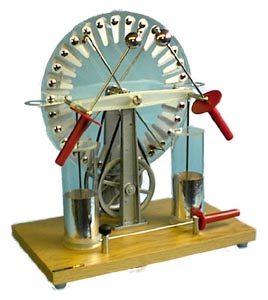Wimshurst Generator
SED 695B; Fall 2005
Principles illustrated:
- Charge by touch
- Charge by induction
- Capacitors
- Static Electricity

Standards addressed:
No standard is directly related to the Wimshurst, but the following apply in an indirect way.
H.S. Physics
5j. Students know electric and magnetic fields contain energy and act as vector force fields.
5o. Students know how to apply the concepts of electrical and gravitational potential energy to solve problems involving conservation of energy.
Wimshurst Generator
Any other static electricity demonstration equipment you wish to use. Generally, anything that will work for a Van de Graaff will work with a Wimshurst.
The Wimshurst generator consists of two wheels with metallic areas on each that rotate in opposite directions. Metal bristles brush against each wheel. One wheel has charges deposited through the touching of dissimilar metals. Charges deposited on this wheel induces opposite charges on the conductor sections of the other wheel. Charges are stored in Leyden jars and can reach a potential of several tens of thousands of volts depending on the size of the wheels. A discharge takes place through two insulated balls that can be moved closer or farther apart. If the Leyden jars are shorted out of the system, lower potentials can still be produced and sparking will occur more frequently, but over a shorter dustance.
Procedure: Use the handle to rotate the disks. As the speed of the disks increases the potential they produce increases as well. If the Leyden jars are left in the circuit, potentials of over 100,000 volts will create "sparks" jumping across from one ball to another at lengths of up to three or four inches. In dry air the potential required to jump across the electrodes is approximately 30,000 volts per inch. The Wimshurst can be used as a static electricity generator for any standard static electricity demonstration.
- Using a Pompom: Attach a cheerleaders pom pom to one of the terminals and the strands will rise, just as a persons's hair will stand when charged to significant potentials. If the strands of the pompom are removed and attached to a metal rod, the rod can be used to touch the electrodes. The charges will travel through the rod and distribute themselves in the pompom.
- Using Styrofoam Peanuts: A small box of packing peanuts, made from styrofoam, when placed on one of the electrodes will cause the packing peanuts to jump around, like jumping beans. The peanuts, covered by charges, will repel each other.
- Using a Neon Bulb: A neon lightbulb placed near an electrode when held by hand, will light up due to the current passing through it.



References & Links:
- Powerlabs Wimshurst Page
- W. Beaty's Static Electricity Page (Very good general site with many links to other resources)
- Leyden Jars
- Leyden Jar Explanation from UCLA
- Capacitors (The function of the Leyden jars)
- Nice video showing fire in gas station due to static electricity (From www.pei.org)